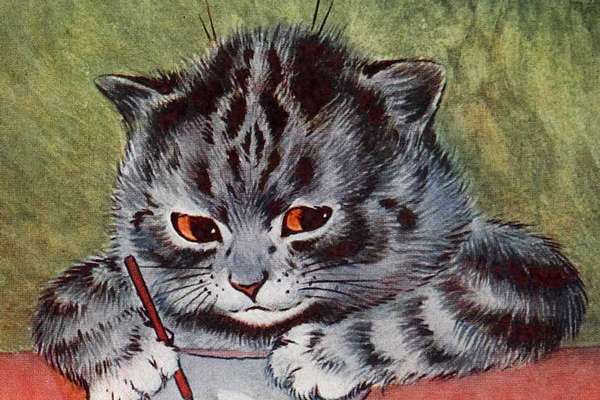In pictures
Tom Smith’s Christmas crackers
In the 1840s confectioner Tom Smith invented the first Christmas cracker. His company became the leading manufacturer of the festive tradition. These cracker box labels, from our copyright registration records, show the creative ways he themed his crackers, tapping into popular interests of the day.
'Marconi Messages'

- Date
- 1907
- Catalogue reference
- COPY 1/259
In the 1840s, confectioner Tom Smith started wrapping paper mottoes into his bonbon sweets. Through his experimentation, he invented the Christmas cracker – the festive tradition that goes off with a 'pop' containing a hat, a motto, and a small gift. Through the years, Tom Smith regularly developed new cracker designs that referenced popular new innovations.
This cracker box label was designed by Paul Fischer and was registered for copyright protection in 1907 with the Stationers’ Company, who dealt with this regulation at the time. 'Marconi Messages' was inspired by the invention of the wireless telegraph, or radio, by Italian inventor Guglielmo Marconi in 1895. The illustration shows a group of people in evening dress staring in awe at radio signals emanating from a huge Christmas cracker.
These designs are held in the copyright registration records at The National Archives, COPY 1.
'Christmas Tree Crackers'

- Date
- 1907
- Catalogue reference
- COPY 1/259
Tom Smith’s 'Christmas Tree Crackers' were designed to appeal to children, and this box label shows a more traditional illustration of a group of children dancing around a Christmas tree. On the tree are gifts including dolls and musical instruments. The label advertises that the crackers contain ‘toys, flags, jewels, hats, caps and children’s mottoes’. The label was designed by Gus Rosenthal.
At the bottom of the box label is a warning ‘caution: see Tom Smith’s name on every box’. While Tom Smith was the leading manufacturer of crackers, there were other competitors, and the company wanted to encourage customers to only purchase official Tom Smith crackers. The year before this box label was created, Tom Smith & Co. was granted its first Royal Warrant (issued to companies who regularly supply goods or services to the Royal Household) by the then Prince of Wales.
'Louis Wain's Cats Crackers'

- Date
- 1907
- Catalogue reference
- COPY 1/259
Tom Smith was very good at tying his products in with popular culture to attract customers. In the early 20th century, one of the most popular illustrators was Louis Wain, famous for his quirky drawings of anthropomorphic cats. In 1907 Tom Smith registered this cracker box label, with a Louis Wain illustration, boasting that Louis Wain’s cats could be ‘found in Tom Smith’s Crackers’.
In the copyright entry form attached to this label, the copyright owner is listed as Tom Smith & Co. Limited of Wilson Street, Finsbury Square, London, and the author is Louis Wain of Bendigo, Westgate-on-Sea.
'Telephone Crackers'

- Date
- 1878
- Catalogue reference
- COPY 1/42/210
This cracker box label is an earlier example of Tom Smith’s promotional material. It was designed by artist Jean Gabriel Faustin Betbeder and registered for copyright protection with the Stationers’ Company in 1878. It promotes ‘Telephone Crackers’ with an illustration of a man and woman using a cup and string telephone. It tied directly into popular excitement around the invention of the telephone at the time. In January of the same year, Alexander Graham Bell successfully demonstrated the telephone to Queen Victoria at Osborne House, her home on the Isle of Wight, before beginning to market his telephones in the UK.
'Crackers from Clubland'

- Date
- 1899
- Catalogue reference
- COPY 1/155
Tom Smith’s ‘Crackers from Clubland’ celebrate the gentleman’s club. These private social clubs were at their height in the late 19th century when this cracker box label was designed. In the illustration, created by Gus Rosenthal, men in evening dress are pictured smoking, drinking, reading newspapers and playing cards. It is not clear what kinds of novelties might have been enclosed in these crackers from Tom Smith.
'Motoring Crackers'

- Date
- 1907
- Catalogue reference
- COPY 1/259
The exciting new pursuit of motor car driving is celebrated by Tom Smith’s ‘Motoring Crackers’. The label for these crackers, designed by Gus Rosenthal, shows three groups of people driving their motor cars down a country lane, at what looks like great speed. Motor cars were rapidly gaining popularity at the turn of the 20th century. Between 1900 and 1930 the number of cars on Britain’s roads increased from less than 1,000 to one million.
Featured article
The story of
Louis Wain

Artist and illustrator Louis Wain (1860–1939) achieved great fame for his whimsical drawings of cats, but his story is also a sad one of personal tragedy.